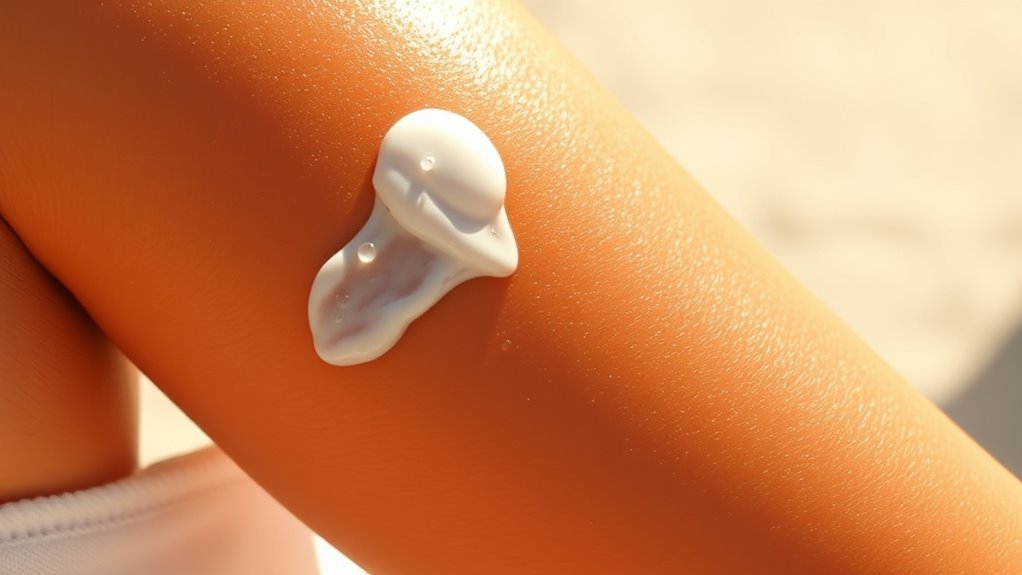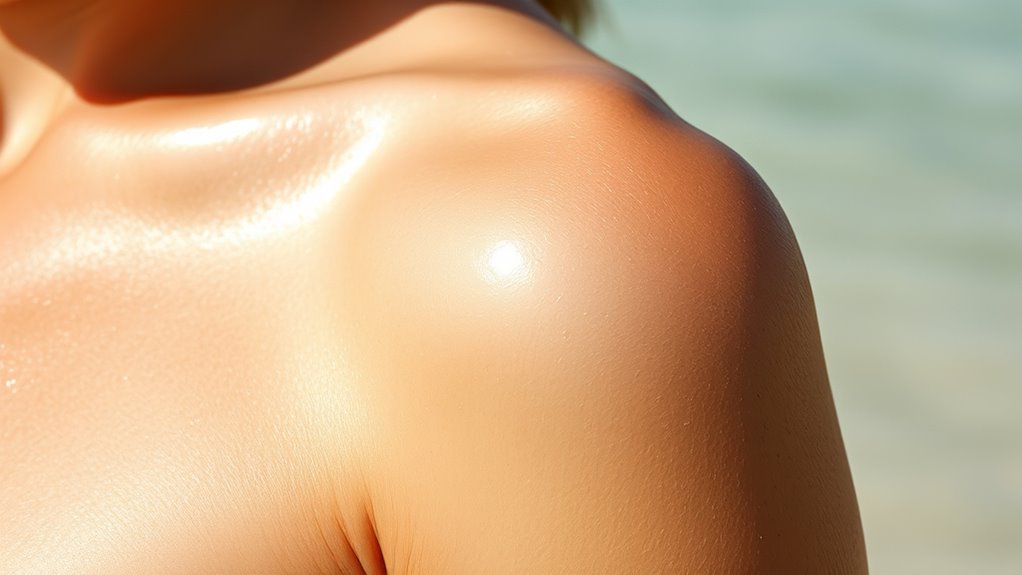To effectively protect your skin, you should apply about one ounce of sunscreen—roughly a shot glass full—for full body coverage. Use a generous, even layer, focusing on all exposed areas like your face, neck, and tricky spots like behind ears or the backs of your feet. Reapply every two hours or after swimming or sweating. To guarantee you’re fully protected, understanding the right amount and proper reapplication is key—more details await if you keep exploring.
Key Takeaways
- Use approximately one ounce (a shot glass full) of sunscreen for full-body coverage.
- Apply a nickel-sized amount to the face and neck for adequate protection.
- Cover all exposed skin evenly, including tricky spots like behind ears and behind knees.
- Reapply every two hours, or more often if swimming or sweating.
- Ensure thorough, even application to prevent missed areas and maintain effective sun protection.

Applying sunscreen to your body is essential for protecting your skin from harmful UV rays, especially during outdoor activities. Without proper application, your skin is vulnerable to sunburn, premature aging, and even skin cancer. But knowing how much sunscreen to use isn’t always straightforward. Many people underestimate the amount needed to create an effective barrier against the sun’s rays. The general rule is to apply about one ounce, or a shot glass full, for full body coverage. This amount ensures that every exposed area is adequately protected. If you’re just applying sunscreen to your face and neck, a nickel-sized dollop is usually enough, but for your entire body, that one-ounce guideline works best to avoid under-application.
You want to start by covering all exposed skin evenly. Don’t just slap the sunscreen on your arms or legs; take the time to spread it thoroughly, making sure to reach tricky spots like behind your ears, the back of your neck, and the tops of your feet. Remember, applying too little won’t provide the necessary protection and increases your risk of sun damage. It’s a common mistake to think a quick, light layer is enough, but that often leaves patches of skin unprotected. To ensure proper coverage, divide your body into sections—arms, legs, torso, and face—and apply the recommended amount to each part. This method helps you avoid missing spots and guarantees you’re using enough sunscreen for all exposed areas.
Reapplying sunscreen is just as important as the initial application. Even if you start with the right amount, sunscreen can wear off or be rubbed away through sweating, towel drying, or contact with clothing. Reapply every two hours, and more often if you’re swimming or sweating heavily. Remember, even water-resistant sunscreens aren’t completely waterproof, so don’t skip reapplying after swimming or sweating profusely. If you’re planning to spend a long day outdoors, bring enough sunscreen to refresh your coverage throughout the day. Keep in mind that more isn’t always better—applying too much doesn’t increase protection but can lead to a greasy feeling or excessive residue. Aim for a generous, even layer, and reapply as needed.
Additionally, understanding the importance of layer concepts in sunscreen formulation can help you choose products that provide optimal protection across different environments and activities. Ultimately, the key is to use enough sunscreen to form a consistent protective barrier over your skin. Proper application, combined with frequent reapplications, ensures you’re doing everything possible to shield yourself from the sun’s damaging rays. Being mindful of how much you’re putting on and reapplying regularly makes a significant difference in maintaining healthy skin and enjoying outdoor activities without worry.
Frequently Asked Questions
Can I Wear Sunscreen Over Moisturizer or Makeup?
Yes, you can wear sunscreen over moisturizer or makeup. In fact, applying it last guarantees your skin gets proper protection. First, moisturize your skin to keep it hydrated, then apply sunscreen generously, covering all exposed areas. If you’re wearing makeup, choose a broad-spectrum sunscreen that works well under foundation or consider a makeup with SPF. Just make sure to reapply every two hours for continuous protection.
How Often Should I Reapply Sunscreen During the Day?
You should reapply your sunscreen every two hours, like clockwork, to keep your skin protected. If you’re swimming, sweating, or towel-drying, reapply immediately—think of it as renewing your shield against harmful rays. Don’t forget, higher SPF options last longer, but regular reapplication is key to staying safe in the sun. Make reapplying a routine, and your skin will thank you for it.
Is Waterproof Sunscreen More Effective Than Regular Sunscreen?
Waterproof sunscreen is more effective than regular sunscreen when you’re swimming or sweating because it stays on your skin longer. However, no sunscreen is completely waterproof; it can still wear off over time. You should reapply it every two hours, especially after swimming or sweating. Always choose a broad-spectrum sunscreen with at least SPF 30 for the best protection, regardless of whether it’s labeled waterproof or not.
Can Sunscreen Prevent All Types of Skin Damage?
Sunscreen is like a shield, but it can’t block all harm. It helps prevent sunburn, skin aging, and some skin cancers, but it doesn’t protect against every kind of damage, like UVA rays that penetrate deeply. To maximize protection, reapply often, wear protective clothing, and seek shade. Remember, no sunscreen alone can fully prevent all skin damage, so combine strategies for the best defense.
What Ingredients Should I Look for in Sunscreen for Sensitive Skin?
Look for sunscreens with zinc oxide or titanium dioxide, as these mineral ingredients are gentle on sensitive skin and provide broad-spectrum protection. Avoid formulas with alcohol, fragrances, or chemical filters like oxybenzone and avobenzone, which can cause irritation. Choose a sunscreen labeled “hypoallergenic” or “for sensitive skin,” and test a small patch first. This way, you protect your skin without risking unnecessary irritation.
Conclusion
Remember, applying enough sunscreen is like laying a sturdy shield against the sun’s relentless rays. Don’t skimp—use about a shot glass full to cover your body, ensuring you’re truly protected. Without this barrier, your skin is as vulnerable as a wave to the tide. So, be diligent and generous with your application. After all, your skin’s health is the foundation of your radiant, sun-kissed glow, shining brighter when guarded well.









